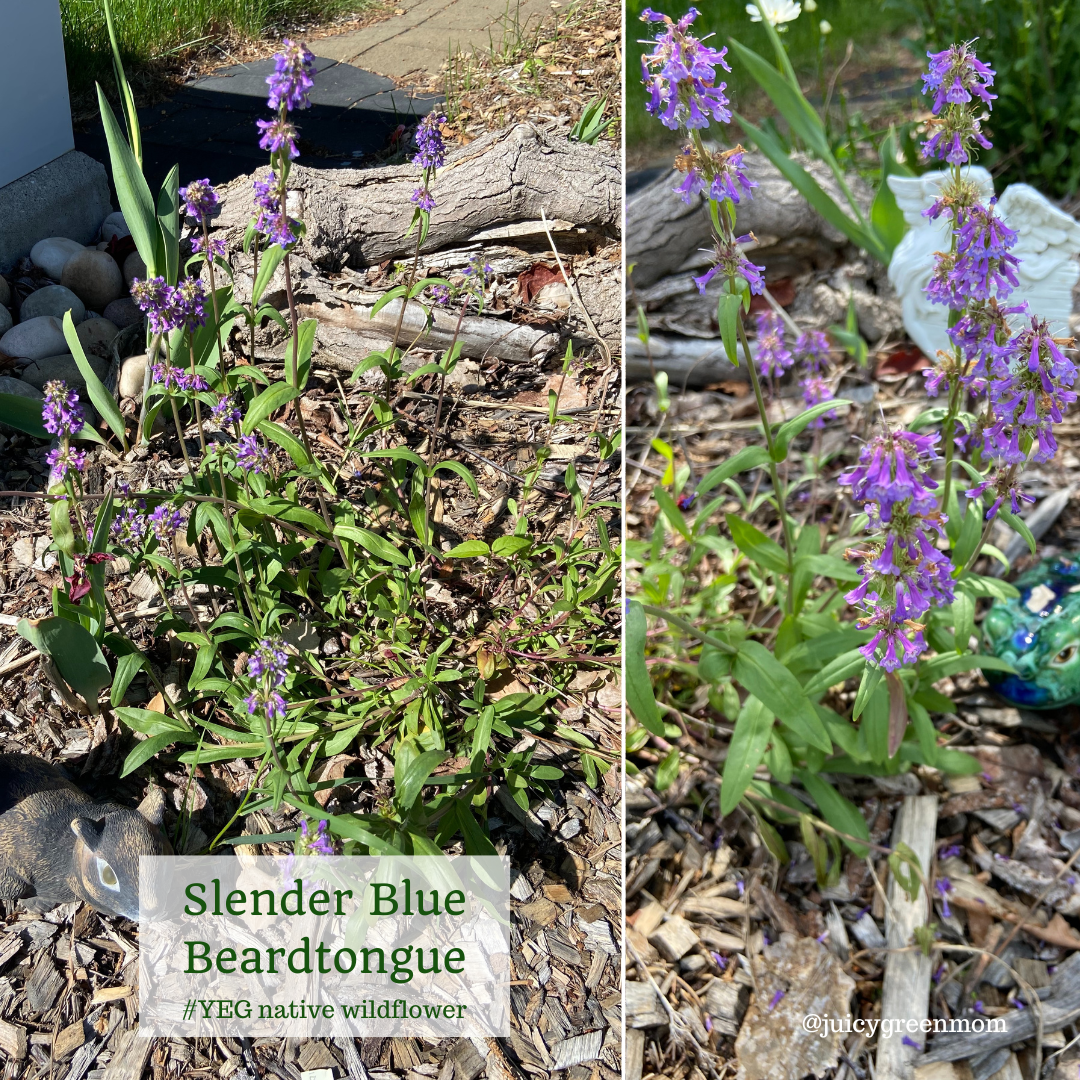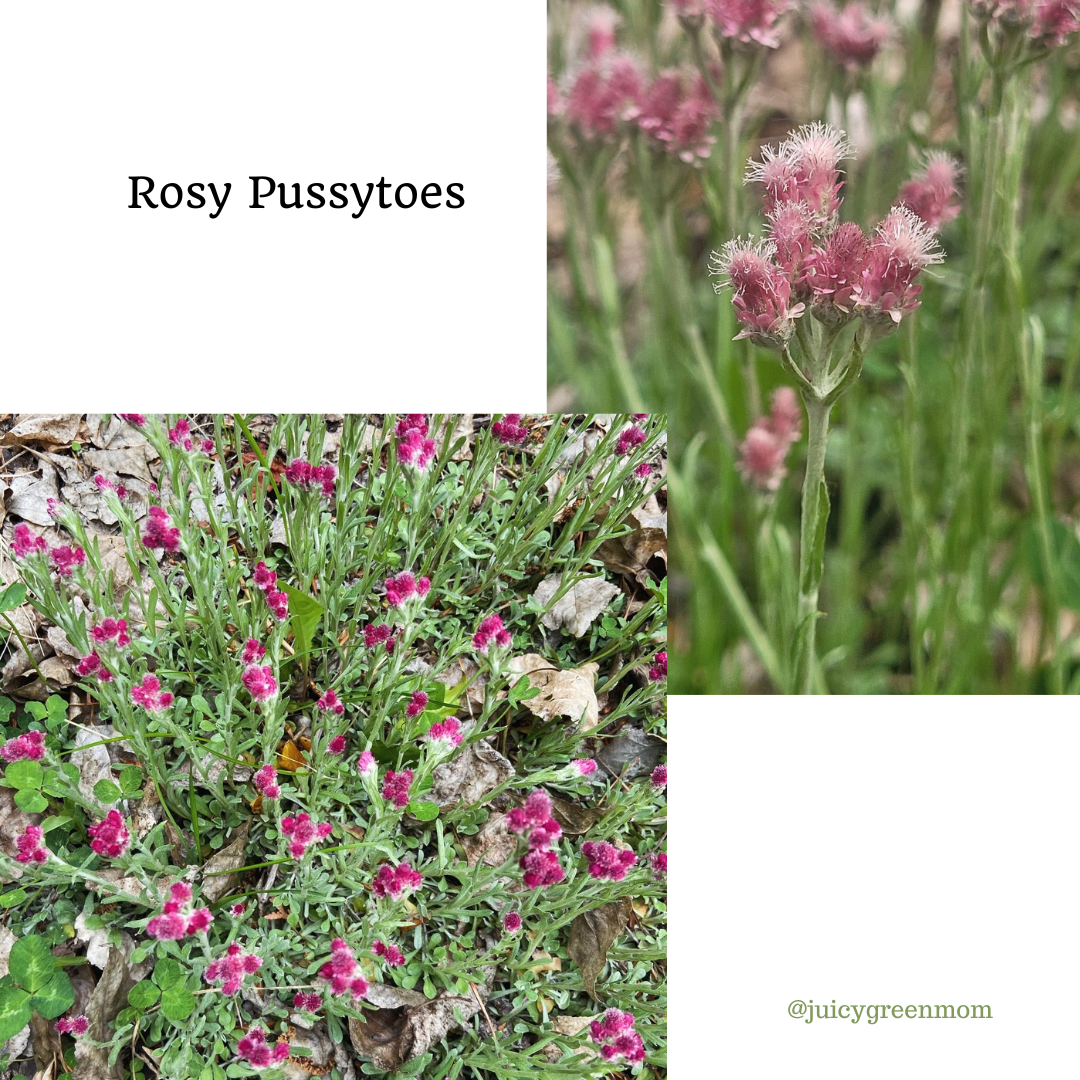Planting Native Wildflower Seeds (Aspen Parkland Ecoregion)
These wildflowers are native to the Edmonton area and the Aspen Parkland Ecoregion (get your ecoregion guide at Pollinator Partnership or Pollinator Partnership Canada). The term “native… refers to a plant that was growing here before the first settlers arrived” (Go Wild, ENPS book resource listed at the bottom of this post).
Cultivars are species bred by the horticultural industry for specific characteristics, derived from native plants. Some cultivars can still be beneficial for pollinators, but others can have a different chemical composition of nectar or pollen, providing less food for pollinators. Therefore, planting native is the most beneficial for pollinators, especially native species.
Check out my How to Create a Butterflyway post and my post about Biodiversity to learn more about the WHY behind planting native wildflowers.
I’m going to be honest, most of the native wildflowers I have in my yard were from baby plants I purchased from Arnica Wildflowers. It is only after having these plants established in my yard that I have tried my hand at growing them from seed. When I first tried growing from seed, I was discouraged because I didn’t see anything coming up. BUT - it turns out there’s a good reason for that! So, just know that planting native wildflowers from seeds takes a bit more persistence and patience than the regular old seeds you buy at the garden centre.
How to plant native wildflower seeds
When planting native wildflower seeds, there are some considerations that are different from cultivars you may find more commonly at garden centres.
Native plants have evolved so that “only a few of the seeds produced each year germinate the first year. The rest wait one or more years to sprout. In this way nature ensures that there are always seeds in the ground waiting to germinate, if some natural disaster wipes out the parent plants.” (Go Wild) This means that when you are trying to grow them from seed, you might become frustrated that you don’t see anything happening. Here are some strategies for dealing with this:
Sow more seeds than you need in order to get some germination of enough plants.
Plant your seeds in a container rather than directly in the ground so you can have a clear label of what seeds you’ve put in (I have found success with using milkjugs or larger containers so I can put quite a bit of seed and have space for seedlings to grow if the seeds germinate). You can take out the seedlings that germinate and sprout once they’re ready to be transplanted, and then continue adding more of the same seed to that container every year to keep germinating more seeds.
Cold stratification
Some seeds need a cold and damp period before they will germinate. This occurs naturally if you plant in late fall before freezing. You can also cold stratify your seeds artificially by putting seeds in a bag with some damp sand and keeping in your fridge for six to eight weeks.
More Tips for Planting
David Suzuki Foundation has some great resources about SEED SITTERS - how you can plant your native wildflower seeds in the fall or winter for the best success in the spring! (If you’re in the Edmonton area or greater Aspen Parkland Ecoregion, I love to share seeds! Send me a message!)
Native Wildflowers in My Garden
Meadow Blazingstar (Liatris ligulistylis)
plant height: less than or equal to 24”
bloom time: July-August
grows in sun
seeds germinate well. sow in late fall or late spring. seedlings will look like little blades of grass. doesn’t usually flower until the third year. does not spread and rarely self-seeds.
Slender Blue Beardtongue (Penstemon procerus)
plant height: less than or equal to 18”
bloom time: May-June
grows in sun
plant seeds in late fall, just pressing into soil, not covering them up. require cold stratification. high germination rate. seedlings will be slow-growing, and bloom in the second year. short lived perennial, but self-seeds freely. cut off faded flowers to encourage it to bloom again in August-September.
Low Goldenrod (Solidago missouriensis)
plant height: less than or equal to 16”
bloom time: July-August
grows in sun
low germination rate. sow seeds in late fall. requires cold stratification. will spread into a nice patch but is not an aggressive spreader.
Smooth Fleabane (Erigeron glabellus)
plant height: less than or equal to 20”
bloom time: July-August
grows in both sun + partial shade
fairly high germination rate. sow seeds into garden in late spring.
Meadow Arnica (Arnica chamissonis)
plant height: less than or equal to 30”
bloom time: June-July
grows in sun
sow seeds in late fall or late spring directly into garden. spreads by underground rhizomes - meaning it will pop up all over if you allow it. has shallow roots so it’s easy to dig out.
Canada Anemone
plant height: less than or equal to 32”, can be used as groundcover
bloom time: May-June
grows in sun + shade
plant seeds in fall. requires double cold stratification - 2 seasons to germinate. low germination rate. spreads aggressively via rhizomes
Smooth Aster (Aster laevis)
plant height: less than or equal to 40”
bloom time: August-September
grows in sun
plant seeds in fall. requires cold stratification. low germination rate.
Lindley’s Aster (Symphyotrichum ciliolatum)
plant height: less than or equal to 60”
bloom time: August-September
grows in both sun + partial shade
plant seeds in fall. requires cold stratification. low germination rate.
Rosy Pussytoes (Antennaria rosea)
plant height: less than or equal to 20”, groundcover
bloom time: April-September
grows in sun + partial sun
plant seeds in fall. seeds do better with cold stratification.
Wild Blue Flax (Linum lewisii)
plant height: less than or equal to 24”
bloom time: June-July
grows in sun
plant seeds in late spring. will stay small during first year of growth, but will grow more and bloom in its second year. short-lived perennial but self-seeds easily.
plant height: less than or equal to 36”
bloom time: July-August
grows in both sun + partial shade
high germination rate. plant seeds in garden mid-June. seedlings are fast-growing. does not spread from roots, but can self-seed.
Note: many cultivars (non-native varieties) are available at garden centres, often sold under the name “Anise Hyssop”.
Joe Pye Weed (Eutrochium maculatum)
plant height: less than or equal to 60”
bloom time: August-September
grows in both sun + partial shade
plant seeds in fall. requires cold stratification. press seeds into soil and barely cover them - they need light to germinate. low germination rate.
Bee Balm/ Wild Bergamot (Monarda fistulosa)
plant height: less than or equal to 24”
bloom time: July-August
grows in sun
plant seeds late spring. high germination rate. seedlings grow fairly quickly. will spread into a nice clump but not aggressively.
Note: cultivated varieties are developed from Scarlet Bergamot, which is a close relative. However they will not be as adaptable to our weather conditions as the native variety.
Three-Flowered Avens/ Prairie Smoke (Geum triflorum)
plant height: less than or equal to 16”
bloom time: May-June
grows in sun
plant seeds in late spring and barely cover them, or just press them uncovered into the soil. good germination rate. each plant will spread into a small colony about 12” across, so can be used as ground cover.
plant height: less than or equal to 20”, can be used as groundcover
bloom time: April-May
grows in shade, prefers morning sun
plant seeds in the fall. seeds do better with cold stratification.
Heart-Leaved Alexander (Zizia aptera)
plant height: less than or equal to 24”
bloom time: June-July
grows in sun + partial shade
plant seeds in fall. seeds require cold stratification. low germination rate.
plant height: less than or equal to 40”
bloom time: July-August
grows in sun + partial shade
plant seeds in the fall. seeds need to be scarified and then cold stratified in order to germinate. low germination rate. spreads by rhizomes. easiest to propagate by dividing established clumps.
Scarification: nick the seed coat and rub gently with coarse sandpaper
Tall Lungwort (Mertensia paniculata)
plant height: less than or equal to 30”
bloom time: June-July
grows in shade + partial shade
plant seeds in fall. seeds germinate better with cold stratification. spreads by rhizomes.
Prairie Crocus (Anemone patens)
plant height: less than or equal to 20”
bloom time: April-May
grows in sun
plant seeds in pots as they are slow to germinate and grow slowly for the first few months. young plants will spend their first 1-2 years growing an extensive root system, and don’t typically flower until their third growing season.
Blanketflower/Brown-Eyed Susan (Gaillardia aristata)
plant height: less than or equal to 24”
bloom time: July-August
grows in sun
will form a small clump when mature but does not spread. plants self-seed occasionally. plant seeds in late spring or late fall. short-lived perennial, so growing more plants is ideal. they form deep taproots and don’t like to be moved.
Note: There are many different species of blanketflower (cultivars) that are not native to the Aspen Parkland Ecoregion, which are also very good for pollinators. However if you are looking for the native variety, be sure to pay attention to the species name.
Common Tall Sunflower (Helianthus nuttallii)
plant height: less than or equal to 72”
bloom time: August-September
grows in sun
plant seeds in late fall directly into garden. seeds do better with cold stratification. low germination rate. spreads via rhizomes, but shallow-rooted so easy to dig up.
Rhombic-Leaved Sunflower (Helianthus subrhomboideus)
plant height: less than or equal to 48”
bloom time: August-September
grows in sun
plant seeds in late spring or late fall directly into garden and make sure they are covered. low germination rate. seedlings are slow-growing at first. spreads via rhizomes.
Blue-Eyed Grass (Sisyrinchium montanum)
plant height: less than or equal to 10”
bloom time: July-August
grows in sun + partial shade
plant seeds in late fall. requires cold stratification. low germination rate. seeds may not germinate until the second year. if they don’t germinate the first year, bury the pots up to the rim for the winter, and check again the following year.
What native wildflowers have you put in your garden?
Resources
book: Go Wild! With Easy to Grow Prairie Wildflowers and Grasses by Cherry Dodd and the Edmonton Native Plant Society (available for purchase via the ENPS website and Arnica Wildflowers).
Purchase seeds from ENPS at various Edmonton-area shops such as Apache Seeds, Wildbird General Store, Wild Birds Unlimited, and Salisbury Greenhouse. They also hold native plant sales periodically throughout the growing season.
City of Edmonton native plant resources - lots of downloadable pdfs with plant information!
Edmonton & Area Land Trust has great information on how to protect pollinators, as well as easy ways to make a bee hotel!
ALCLA Native Plants (located in Carstairs, Alberta) sells seeds and has great information about native seed germination.


















